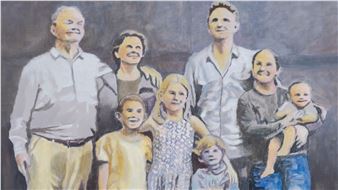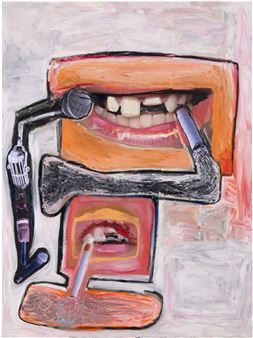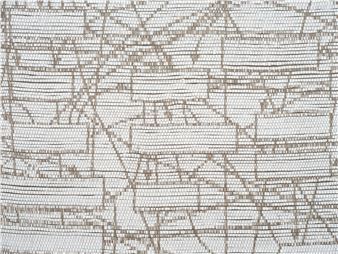Antony Gormley: CONSTRUCT
The exhibition begins with a life-size work from GormleyвҖҷs series of вҖҳBodycases,вҖҷ Bridge (1985), in the front gallery space. This is one of the earliest works made from a plaster mould of the artistвҖҷs body, strengthened with fiberglass and encased in a skin of lead. Gormley sees Bridge as an objective mapping of the subjective space of the human body. The visible soldering lines on its surface form clear horizontal and vertical axes: the body is treated as the location of physical and spatial experience. Bridge is presented alongside the wall relief MotherвҖҷs Pride IV (1982, remade in 2012), in which an impression of the artistвҖҷs body in the foetal position has literally been eaten out of a tightly packed grid of slices of industrially produced вҖҳMotherвҖҷs PrideвҖҷ white bread. Also on view alongside these works is Scaffold (2015), a recent work in which Gormley has translated the grid of horizontal and vertical lines of Bridge into a freestanding, three-dimensional mapping of the internal volumes of the body. Together these three works propose that we consider the body less as an object and more as a site and agent of transformation.
In the main gallery, the artistвҖҷs exploration of the potential of the вҖҳmappingвҖҷ of body space continues with boldly physical sculptures that increase the dynamic between space and mass. Visitors will encounter five new monumental works from GormleyвҖҷs recent вҖҳBig BeamerвҖҷ series. These previously unexhibited works deconstruct and reassemble the interior volume of the body through interlocking steel beams that run in all three axes. Created at one-and-a-half-times life-size, they represent a body in five unstable moments of restвҖ”from crouching to fully erect. In spite of their grand scale, the works remain remarkably playful.
CONSTRUCT concludes in the lower gallery space with two new вҖҳStretched Blockworks.вҖҷ These works continue the artistвҖҷs engagement with the massive volumes of architecture by using rectangular iron blocks to translate body space into mass. Unlike the вҖҳBig Beamers,вҖҷ these volumes are stretched along a single axis to echo the forms of classic New York high-rises of the early twentieth century.
Concurrent with the exhibition at Sean Kelly, Gormley's latest site-specific permanent public installation,Chord, will be on view at the Massachusetts Institute of Technology in Building 2вҖ”which houses the Department of Mathematics and sections of the Department of ChemistryвҖ”beginning April 23, 2016. A 40- foot-high spiral column made from a myriad of polyhedra, the work connects the floor of the buildingвҖҷs central staircase to the skylight. In contrast to the fixity of the classical column or Brancusi's Endless Column, which make a solid bridge between above and below, Chord evokes a dynamic relationship between matter and energy in connecting earth to sky.
The exhibition begins with a life-size work from GormleyвҖҷs series of вҖҳBodycases,вҖҷ Bridge (1985), in the front gallery space. This is one of the earliest works made from a plaster mould of the artistвҖҷs body, strengthened with fiberglass and encased in a skin of lead. Gormley sees Bridge as an objective mapping of the subjective space of the human body. The visible soldering lines on its surface form clear horizontal and vertical axes: the body is treated as the location of physical and spatial experience. Bridge is presented alongside the wall relief MotherвҖҷs Pride IV (1982, remade in 2012), in which an impression of the artistвҖҷs body in the foetal position has literally been eaten out of a tightly packed grid of slices of industrially produced вҖҳMotherвҖҷs PrideвҖҷ white bread. Also on view alongside these works is Scaffold (2015), a recent work in which Gormley has translated the grid of horizontal and vertical lines of Bridge into a freestanding, three-dimensional mapping of the internal volumes of the body. Together these three works propose that we consider the body less as an object and more as a site and agent of transformation.
In the main gallery, the artistвҖҷs exploration of the potential of the вҖҳmappingвҖҷ of body space continues with boldly physical sculptures that increase the dynamic between space and mass. Visitors will encounter five new monumental works from GormleyвҖҷs recent вҖҳBig BeamerвҖҷ series. These previously unexhibited works deconstruct and reassemble the interior volume of the body through interlocking steel beams that run in all three axes. Created at one-and-a-half-times life-size, they represent a body in five unstable moments of restвҖ”from crouching to fully erect. In spite of their grand scale, the works remain remarkably playful.
CONSTRUCT concludes in the lower gallery space with two new вҖҳStretched Blockworks.вҖҷ These works continue the artistвҖҷs engagement with the massive volumes of architecture by using rectangular iron blocks to translate body space into mass. Unlike the вҖҳBig Beamers,вҖҷ these volumes are stretched along a single axis to echo the forms of classic New York high-rises of the early twentieth century.
Concurrent with the exhibition at Sean Kelly, Gormley's latest site-specific permanent public installation,Chord, will be on view at the Massachusetts Institute of Technology in Building 2вҖ”which houses the Department of Mathematics and sections of the Department of ChemistryвҖ”beginning April 23, 2016. A 40- foot-high spiral column made from a myriad of polyhedra, the work connects the floor of the buildingвҖҷs central staircase to the skylight. In contrast to the fixity of the classical column or Brancusi's Endless Column, which make a solid bridge between above and below, Chord evokes a dynamic relationship between matter and energy in connecting earth to sky.

 ARTISTS
ARTISTS











